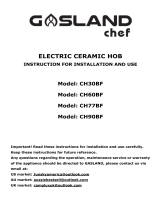
IMPORTANT SAFETY INSTRUCTIONS
IMPORTANT: Read the assembly instruction section and safety precautions of this booklet carefully before
removing the contents of this carton.
1. This appliance is not intended for use by persons (including children) with reduced physical, sensory or mental
capabilities, or lack of experience or knowledge, unless they have been given supervision or instruction concerning the
use of the appliance by a person responsible for their safety. Children should be supervised to ensure that they do not
play with the appliance.
2. After removing the packaging, make sure to check if there is any damage to the appliance. If there is any damage (including
cracked glass), never attempt to use the appliance and immediately contact your Authorised Service Centre. As packaging
materials can be dangerous to children, they need to be collected immediately and put out of reach.
3. In certain circumstances electrical appliances may be a safety hazard. Check the conformity of voltage and power settings,
which are specified on the information plate attached to the appliance and/or packaging.
4. Do not place heavy objects in or on these appliances, use for storage or as a cutting surface. This appliance is designed for
cooking food only. Use flat based, stable cooking pots only.
5. This appliance is designed for domestic household use only and for the cooking of domestic food products. Use as a
commercial appliance will void the warranty. It should not to be used in a marine environment or outdoors and must be fully built
in. Do not use the appliances until fully installed.
6. This appliance is supplied with a 15-amp plug. The plug has a large earth terminal that will not fit into a common
electrical socket. To install the appliance, a special socket is required to be installed by a licensed electrician (if it does
not already exist at the point of installation). If the electrical supply cord is damaged, either when being installed or after
installation, it must be replaced by the manufacturer, its service centre or similarly qualified persons in order to prevent
a hazard.
7. A means for disconnection must be incorporated in the fixed wiring in accordance with the wiring rules.
8. The electrical connection must be accessible after installation. The appliance must be electrically isolated before any
maintenance can be performed. Electrical connection must be made as per local wiring rules and regulations.
9. The appliance is not intended to be operated by means of an external timer or separate remote-control system.
10. Ensure that the kitchen is well ventilated or mechanical ventilation is in use while cooking on this appliance.
11. Do not store or use flammable materials or aerosols near the cooktop. Items made from aluminium, plastic or plastic film should
also be kept away from the appliance, as they may fuse to the surface.
12. WARNING - The appliance will become hot during and directly after use. Do not touch the surface during this time, as it may be
hot and can cause burns. To avoid burns, children should be kept away.
13. Cleaning may only be commenced on the appliance once it has cooled down and is turned off. Do not use a steam jet or any
other high-pressure cleaning equipment to clean the appliance.
14. When the appliance is not being used, turn the appliance off.
15. Where this appliance is installed in a caravan, it shall NOT be used as a space heater.
16. Do not modify this appliance.
17. Do not use harsh abrasive cleaners or sharp metal scrapers to clean the glass surface as they can scratch the surface, which
may result in the glass shattering. Clean the glass using a warm damp cloth (e.g. dishcloth) and dry it with a soft dry tea towel.
18. All cabinetry and materials used in the installation must be able to withstand a minimum temperature of 100°C above the
ambient temperature of the room it is in, whilst in use. Certain types of vinyl or laminate kitchen furniture are particularly prone
to heat damage or discolouration at temperatures below the guidelines given above. Any damage caused by the appliance being
installed without adhering to the temperature limits set out above will be the liability of the owner. To avoid any hazards, limit
access to the under-bench section of the cooktop.
19. The appliance must be installed and put into operation by an authorised technician under the conditions provided by the
manufacturer in this manual. The manufacturer cannot be held responsible for any damage that might occur due to faulty
installation. Do not install near cooling equipment, dishwashers or clothes dryers.
20. Damage can occur to bench tops if pots and pans are allowed to overlap the bench top. This can result in heat being
transferred to the bench top. Ensure that correct sized pots & pans are used. Cast iron and cast aluminium cookware with
damaged bases may scratch the cooktop surface if they are dragged across it. Pans should be lifted on and off the appliance
surface and not dragged. Cooking zones should not be switched on without cookware placed on it. Cookware should not be
empty for any length of time when being used on the appliance.
21. WARNING: If the surface is cracked, switch off the appliance to avoid the possibility of electrical shock.
22. Do not leave the appliance while cooking with solid or liquid oils. There may be flaming up in conditions of extreme heating.
23. Never pour water onto the flames occurring from oil. Immediately turn the aappliance off and cover the pan with a lid or fire
blanket in order to smother the flame.












